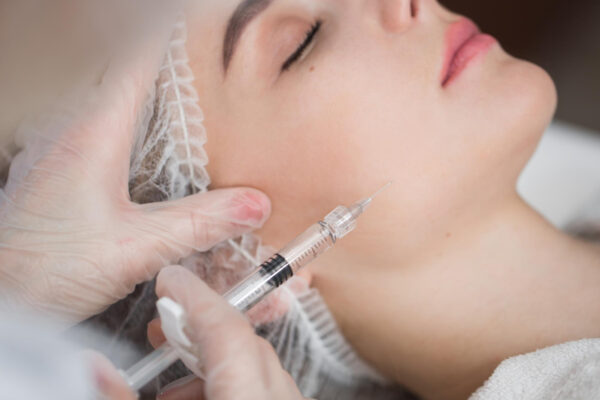
Botox injections treat the hyperactive muscles that cause symptoms like jaw clenching and grinding the teeth in the case of TMJ disorder.
A common condition known as temporomandibular joint disorder (TMJ) causes pain, dysfunction, and discomfort in the mandibular joint and surrounding musculature. Its manifestations can profoundly disrupt daily activities such as mastication, phonation, and sleep. Despite the array of treatment modalities available for TMJ, botulinum toxin, commonly known as Botox, has emerged as a promising therapeutic option, offering solace to sufferers. This article scrutinizes the mechanistic insights, efficacy, and merits of Botox injections in assuaging TMJ symptoms.
Comprehending Temporomandibular Joint Disorder (TMJ)
The temporomandibular joint (TMJ) serves as a pivotal hinge linking the mandible to the cranium, facilitating intricate movements, including chewing, speaking, and yawning. TMJ disorder encompasses a gamut of maladies affecting this joint and its contiguous musculature, ligaments, and nerves. Manifestations of TMJ encompass jaw pain or tenderness, impaired mandibular mobility, audible clicking or popping, and rigidity of the facial musculature.
Some of the things that can cause TMJ disorder are traumatic injuries to the mandible, bad teeth alignment, arthritic processes, bruxism, psychological stressors, or a combination of these. The intricate interplay of these factors renders TMJ disorder a complex entity, often necessitating a multidisciplinary therapeutic approach involving dentists, maxillofacial surgeons, physiotherapists, and other allied healthcare professionals.
Botulinum Toxin: Mechanism of Action and Therapeutic Potential
Botulinum toxin, derived from Clostridium botulinum, emerges as a potent neurotoxic protein renowned for its neuromuscular blocking properties. While its ingestion in substantial quantities can culminate in botulism, the therapeutic repertoire of botulinum toxin spans diverse medical disciplines encompassing neurology, ophthalmology, urology, and dermatology.
The mechanism of action of botulinum toxin revolves around its ability to impede the exocytosis of acetylcholine, a neurotransmitter pivotal for neuromuscular transmission, at the presynaptic membrane. By obviating acetylcholine release, botulinum toxin precipitates temporary muscle paralysis or debilitation, engendering muscle relaxation and ameliorating associated symptoms.
In the case of TMJ disorder, Botox injections target the hyperactive musculature, which is indicative of the condition’s hallmarks, such as exacerbated jaw clenching and bruxism. Botox injections are used to treat TMJ symptoms, specifically in muscles like the masseter and temporalis, that can become hypertonic or overactive due to several factors, such as stress and bad teeth grinding.

Injections of Botox, when administered by trained medical professionals, have an excellent safety profile.
Efficacy of Botox in Treating TMJ
A plethora of clinical investigations and anecdotal testimonies attest to the efficacy of Botox injections in assuaging TMJ-related distress. Empirical evidence corroborates the ability of Botox to mitigate muscle hyperactivity, alleviate pain, and enhance mandibular functionality among individuals grappling with TMJ disorder.
A systematic review and meta-analysis published in the Journal of Oral Rehabilitation looked at how well Botox injections relieve pain and dysfunction caused by TMJ. After studying, it was found that Botox treatments significantly decreased pain levels, improved mandibular mobility, and made patients happier compared to placebo or standard treatments.
Furthermore, Botox injections boast a commendable safety profile under the stewardship of adept healthcare practitioners. These interventions are typically well-tolerated, engendering minimal proclivity for systemic sequelae. Instances of localized adverse effects, such as transient muscular weakness or ptosis, are sporadic and evanescent in nature.
Benefits of Botox for TMJ Sufferers
There are several benefits to incorporating Botox into the treatment arsenal for TMJ disorder compared to more conventional methods. Firstly, Botox confers targeted and localized therapy, directly addressing the hyperactive musculature implicated in TMJ pathology. Botox does not go through the digestive system like oral drugs, so it has fewer systemic side effects and pharmacokinetic interactions.
Secondly, Botox offers a non-invasive alternative to surgical interventions for TMJ management. In severe or persistent cases of TMJ disorder, surgery like arthrocentesis or joint replacement may be necessary. However, Botox injections can be used instead of surgery, either as an additional treatment or as the main treatment for many patients.
Additionally, Botox injections for TMJ are expedient and facile, typically administered in outpatient settings. The interventions entail the judicious administration of fine-gauge needles, yielding minimal discomfort and convalescence for the recipient. Most individuals can promptly resume their daily activities post-procedure.
Moreover, the effects of Botox interventions for TMJ are transient and reversible, spanning approximately three to six months. This temporal attribute confers versatility in therapeutic planning and dosage titration, contingent upon individual responsiveness and symptomatology. Subsequent administrations can be tailored to sustain therapeutic efficacy over prolonged intervals.
Conclusion
Temporomandibular joint disorder (TMJ) constitutes a formidable challenge for afflicted individuals, encroaching upon their oral functionality, vital activities, and overall welfare. Amidst the panoply of therapeutic options available for TMJ, Botox injections have emerged as a promising therapeutic modality, assuaging the pain and dysfunction associated with the condition.
As part of its mechanism of action, Botox effectively targets the pathophysiological causes of TMJ disorder by reducing muscle hyperactivity. Empirical inquiries uniformly validate the potency of Botox in diminishing pain severity, enhancing mandibular functionality, and amplifying patient contentment.
Additionally, there is a slew of benefits to using Botox injections for TMJ, such as the fact that they are precise, non-invasive, convenient, and reversible. Botox has thus become an integral part of the interdisciplinary treatment plan for TMJ disorder, providing hope and relief to people all over the world.
Dentox serves as an epitome of expertise for professionals traversing both medical and aesthetic domains, furnishing comprehensive education on the precise and proficient administration of Botox injections. Boasting an array of conveniently situated classes spanning the expanse of the United States and flexible online learning avenues, Dentox empowers professionals to advance at their preferred pace. Discover live courses at https://dentox.com/live-courses and virtual offerings at https://dentox.com/all-courses/botox-training. Initiate contact with a certified Botox injector today to commence a voyage towards enlightened and impactful aesthetic practices.







